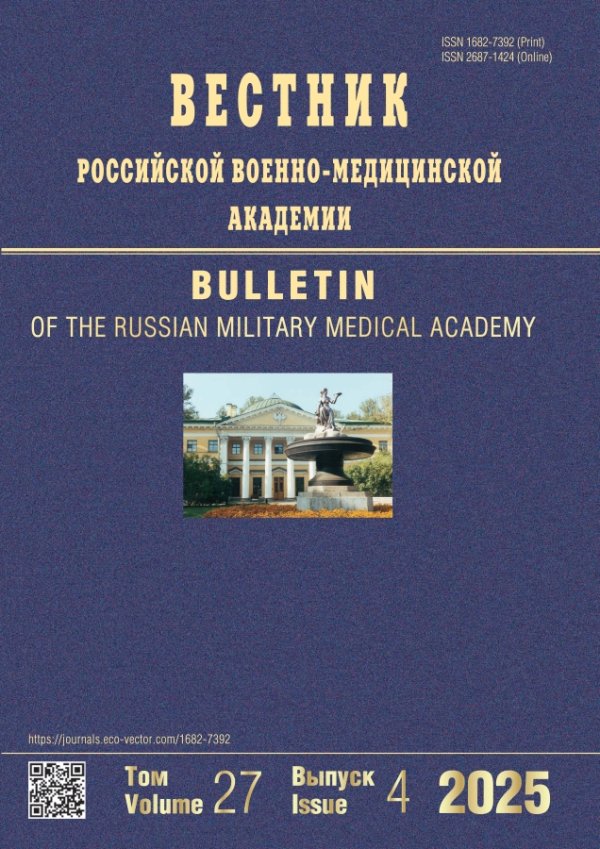Эластография в диагностике фиброза при хронических диффузных заболеваниях печени
- Авторы: Жирков И.И.1, Гордиенко А.В.1, Павлович И.М.1, Яковлев В.В.1, Сердюков Д.Ю.1
-
Учреждения:
- Военно-медицинская академия им. С.М. Кирова
- Выпуск: Том 22, № 4 (2020)
- Страницы: 192-195
- Раздел: Обзоры
- URL: https://journals.rcsi.science/1682-7392/article/view/62827
- DOI: https://doi.org/10.17816/brmma62827
- ID: 62827
Цитировать
Аннотация
Представлены современные сведения о неинвазивной инструментальной методике оценки фиброзных изменений в печени – эластографии. Изложены данные об истории происхождении термина «эластография», даны несколько его определений, а также обращено внимание на основной принцип методики – перкуссию, традиционно применяющуюся при объективном исследовании пациента. Приведены факты о двойственной терминологии наименования данной методики в литературе: часть авторов использует термин «эластография», а другая часть – «эластометрия». При анализе литературы выяснилось, что в зарубежных источниках гораздо чаще используют термин «эластография», а в русскоязычных находят применение оба названия методики. С учетом большей распространенности варианта «эластография» логичнее использовать именно его, однако каждое из этих названий имеет свое право на существование. Даны определения основным физическим понятиям, связанным с методикой эластографии, – «упругость», «жесткость» и «модуль упругости Юнга». С точки зрения применения в клинической практике методики эластографии могут быть разделены на четыре группы: компрессионная эластография, чаще применяющаяся в онкодиагностике, транзиентная, точечная и двухмерная эластография сдвиговой волной, применяющиеся в диагностике фиброза печени. Классификация по физическим основам предполагает деление эластографии на два типа: статическая, к которой относится компрессионная эластография, и динамическая, включающая в себя транзиентную, точечную и двухмерную эластографию сдвиговой волной. Транзиентная эластография реализована в аппаратах семейства «FibroScan», точечная эластография – в ультразвуковых сканерах фирм «Hitachi Aloka», «Siemens» и «Philips», двухмерная эластография сдвиговой волной – в аппаратах компаний «Supersonic Imagine», «Toshiba», «Siemens», «Mindray», «General Electric». Наиболее широкий спектр возможностей для оценки фиброза печени предоставляет двухмерная эластография сдвиговой волной. Сочетанное использование нескольких методик ожидаемо увеличивает диагностическую точность в определении фиброза. Наибольшей точностью среди эластографических методик обладает магнитно-резонансная эластография, но ее применение ограничено из-за сложности и дороговизны оборудования, поэтому данная методика пока не нашла широкого применения в клинической практике.
Ключевые слова
Полный текст
Открыть статью на сайте журналаОб авторах
И. И. Жирков
Военно-медицинская академия им. С.М. Кирова
Автор, ответственный за переписку.
Email: vmeda-nio@mil.ru
Россия, Санкт-Петербург
А. В. Гордиенко
Военно-медицинская академия им. С.М. Кирова
Email: vmeda-nio@mil.ru
Россия, Санкт-Петербург
И. М. Павлович
Военно-медицинская академия им. С.М. Кирова
Email: vmeda-nio@mil.ru
Россия, Санкт-Петербург
В. В. Яковлев
Военно-медицинская академия им. С.М. Кирова
Email: vmeda-nio@mil.ru
Россия, Санкт-Петербург
Д. Ю. Сердюков
Военно-медицинская академия им. С.М. Кирова
Email: vmeda-nio@mil.ru
Россия, Санкт-Петербург
Список литературы
- Аллахвердиева, Я.С. Современные возможности магнитно-резонансных технологий в диагностике ожирения печени / Я.С. Аллахвердиева, С.В. Воробьев, Н.И. Минеев // Мед. вестн. Сев. Кавказа. – 2018. – Т. 13, № 4. – С. 695–701.
- Жирков, И.И. Возможности транзиентной и двухмерной сдвиговолновой эластографии в диагностике фиброза при хронических диффузных заболеваниях печени невирусной этиологии / И.И. Жирков [и др.] // Экспер. и клин. гастроэнтерология. – 2020. – Т. 179, № 7. – С. 40–45.
- Зыкин, Б.И. Эластография: анатомия метода / Б.И. Зыкин, Н.А. Постнова, М.Е. Медведев // Променева діагностика, променева терапія. – 2012. – № 2–3. – С. 107–113.
- Изранов, В.А. Методы эластографии печени и проблемы русскоязычной терминологии / В.А. Изранов [и др.] // Вестн. Балт. фед. ун-та им. И. Канта. – 2019. – № 1. – С. 63–78.
- Изранов, В.А. Физические основы эластографии печени / В.А. Изранов [и др.] // Вестн. Балт. фед. ун-та им. И. Канта. – 2019. – № 2. – С. 69–87.
- Осипов, Л.В. Технологии эластографии в ультразвуковой диагностике. Обзор / Л.В. Осипов // Мед. алфавит. Диагностическая радиология и онкотерапия. – 2013. – № 3–4. – С. 5–21.
- Постнова, Н.А. Компрессионная эластография печени: методика, особенности получения эластограмм, анализ ошибок и артефактов (лекция) / Н.А. Постнова [и др.] // Радиология – практика. – 2015. – Т. 50, № 2. – С. 45–54.
- Тухбатуллин, М.Г. Современные ультразвуковые технологии в клинической практике / М.Г. Тухбатуллин, И.М. Алиева // Практ. мед. – 2012. – № 5. – C. 30–35.
- Физическая энциклопедия: в 5 томах / под ред. А.М. Прохорова. – М.: Большая российская энциклопедия, 1998. – 3544 с.
- Bedossa, P. An algorithm for the grading of activity in chronic hepatitis C. The METAVIR Cooperative Study Group / P. Bedossa, T. Poynard // Hepatology. – 1996. – Vol. 24, № 2. – P. 289–293.
- Dietrich, C.F. EFSUMB Guidelines and recommendations on the clinical use of liver ultrasound elastography, update 2017 (long version). European Federation for Ultrasound in Medicine and Biology (EFSUMB) / C.F. Dietrich [et al.] // Ultraschall in der Medizin. – 2017. – Vol. 38, № 4. – P. 16–47.
- Dulai, P.S. Magnetic resonance imaging and magnetic resonance elastography for non-invasive quantitative assessment of hepatic steatosis and fibrosis in NAFLD and NASH: clinical trials to clinical practice / P.S. Dulai, C.B. Sirlin, R. Loomba // Journal of Hepatology. – 2016. – Vol. 65. – P. 1006–1016.
- Нagström, Н. Fibrosis stage but not NASH predicts mortality and time to development of severe liver disease in biopsy-proven NAFLD / H. Hagström [et al.] // Journal of Hepatology. – 2017. – Vol. 67, № 6. – P. 1265–1273.
- Ophir, J. Elastography: a quantitative method for imaging the elasticity of biological tissues / J. Ophir [et al.] // Ultrasonic Imaging. – 1991. – Vol. 13. – P. 111–134.
- Shiina Т. JSUM ultrasound elastography practice guidelines: basics and terminology / Т. Shiina // Journal of Medical Ultrasonics. – 2013. – Vol. 40, № 4. – P. 325–357.
- Venkatesh, S.K. Magnetic resonance elastography of liver: technique, analysis, and clinical applications / S.K. Venkatesh, M. Yin, R.L. Ehman // Journal of Magnetic Resonance. – 2013. – Vol. 37. – P. 544–555.
Дополнительные файлы







